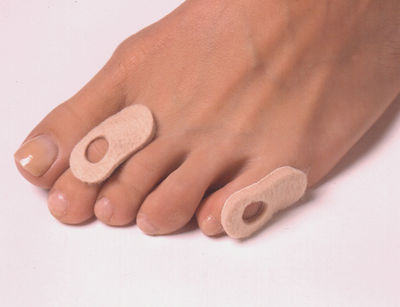 Facts of Corns
Facts of Corns
Corns are an area of hardened skin or callus on the foot. These are made from keratin, or tough protein that are stored in the outermost layer of the skin. As the foot is exposed to friction or pressure these keratin cells will thicken to protect the skin from damage. This is not necessarily harmful, but if they develop on a bony area or swell they can cause pain by placing pressure on the nerves below. Those with diabetes may also find that developing corns is a sign of an infection, particularly if it begins to form an ulcer, which will require treatment.
People can develop hard or soft corns. Hard corns are more common, comprising of hard skin, typically around the boarder of a callus, growing to be around the size of a pea. These are most common around the toes. Soft corns are rubbery and white, often growing between the toes or areas prone to moisture. Symptoms of a corn include pain when walking or performing areas that put pressure on the foot. You will also see an area of hardened skin over an area of the foot.
Corns are caused by wearing improper footwear that does not fit right, performing a lot of exercise or having misshapen feet. People who have prominent bones or had fractures in the foot that did not heal properly are more prone to developing corns.
How to Treat Corns
1. Home Remedies to Treat Corns
Depending on the location or condition contributing to the corn, several home remedies may be helpful in alleviating your discomfort.
- Remove Hard Skin- The skin making up the corn can be carefully removed with a small knife. The callus can also be soaked, and then the patient can gently sand the callus with a pumice stone to remove the excess skin. Those with diabetes should not perform these techniques on their own, particularly if they have a condition that produces numbness in the feet.
- Use Foam Wedges- Protective padding in the shoes help to hold the feet in the proper position so they will not rub. Your doctor can help you determine which pads and positioning is right for you.
- Wear Proper Footwear- Wear shoes with wide, deeptoe boxes that are generally roomy and fit well. This will help prevent your toes from rubbing against each other and will provide air circulation around the toes. Shoes with thicker soles can also help prevent putting pressure on your corns.
- Apply Correctives- Bar inserts in the shoes can help you distribute the weight of your feet more evenly. Athletes will frequently use shoe inserts to help keep their weight remains distributed properly.
- Lose Weight- People who are obese are more likely to develop corns due to the increased pressure on the feet. Losing weight can help alleviate the pain and your likelihood of developing corns on the feet.
- Activity- Patients that suffer from corns should avoid activities that will put excessive pressure on their feet. Any easily avoidable activities that cause strain should be adjusted or eliminated to provide relief.
2. Medical Treatments
When searching for answers to how to treat corns, besides the easy home remedies mentioned above, there are some medical treatments you can consider as well, which include:
- Medicines- Salicylic acid is often available over the counter to assist those with painful corns. Rub the callus with this medication, and then gently use a pumice stone to remove the excess skin. Take care not to apply salicylic acid to the surrounding skin, only applying it to the painful, thick area of the corn. Urea cream and lactic acid can also be used to help dissolve the excess skin of a corn.
- Injection- Fluid silicone can be injected into the foot to help reduce the loss of plantar fat. This has been found to reduce the pain associated with corns, particularly those that have formed above a bone structure. Other fillers have been used for this purpose, but at this time the success of these substances is unknown.
- Surgery- Surgical intervention is rarely needed to treat corns. If the bone structure of the foot is contributing to the condition, surgery may be necessary to perform surgery to alter this condition. This is typically only considered if other treatments have failed. Soft corns may be treated by sewing the skin between the toes together, creating a partial webbing that will prevent an additional corn from developing.